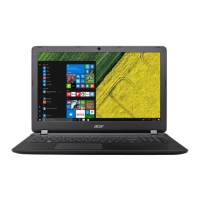
Do you have a question about the Acer N16C1 and is the answer not in the manual?
Information about the setup guide, quick guide, and user's manual for the Acer notebook.
Guidance on how to properly use and maintain your computer and AC adapter.
An overview of the physical components and layout of your Acer notebook.
Explanation of Caps Lock, Num Lock, and Scroll Lock key functions.
Details on keyboard shortcuts for system controls like brightness and volume.
Description of keys with Windows-specific functions, like the Start button.
Instructions for common touchpad operations like scrolling, clicking, and gestures.
Steps to customize touchpad behavior and sensitivity for personal preference.
Procedure to create a backup of your system and installed applications.
How to back up network drivers for potential reinstallation.
Methods to restore your computer to its default or previous state.
Steps to turn the Bluetooth adapter on or off on your computer.
Guide on pairing new devices with your computer's Bluetooth adapter.
Instructions for connecting your computer to a Wi-Fi network.
How to establish an internet connection using an Ethernet cable.
Information on using a SIM card to connect to the internet via cellular networks.
How to adjust Acer Bluelight Shield settings to reduce eye strain.
Methods for protecting your computer using locks and passwords.
How to configure the computer's boot order in the BIOS utility.
Instructions for setting Supervisor and Password on Boot in the BIOS.
Methods to reduce power consumption and improve battery life, including disabling fast startup.
Information about the computer's Lithium battery and its charging behavior.
Steps for charging the battery and conditioning a new battery pack.
Tips and practices to prolong the battery's operational lifespan.
How to view the current charge level of the computer's battery.
What to do when the battery level is low to prevent data loss.
Steps for safely disconnecting external accessories before moving the computer.
How to prepare the computer for travel by shutting down or sleeping.
Items to consider bringing for meetings, such as the AC adapter.
Essential items to carry when traveling with your computer.
Important advice for protecting the computer from environmental factors during travel.
Specific precautions and requirements for international travel with the computer.
Overview of the various ports and connectors available on the computer.
Explanation of USB ports, standards, and proper device removal.
Step-by-step guide on how to insert memory cards into the reader.
Procedure for safely ejecting memory cards from the reader.
Instructions for connecting an external monitor via VGA or DVI ports.
How to connect audio devices like headphones and external microphones.
Explanation of the HDMI port for high-quality audio/video connections.
Troubleshooting steps for power and boot-up issues with the computer.
Solutions for a blank screen, including brightness and display settings.
Steps to troubleshoot issues related to sound output and volume.
How to manually eject the optical drive tray using an emergency hole.
Troubleshooting steps if the keyboard is not functioning correctly.
Basic checks for ensuring the printer is connected and functioning.
Procedure for restoring the computer to its factory default state.
General advice and strategies for diagnosing and resolving computer problems.
List of common error messages and their corresponding corrective actions.
Initial steps for getting online and protecting your computer.
Guidance on selecting an ISP and understanding connection types.
Information about setting up and using wired and wireless network connections.
How to use the internet browser to access online content.
Information on built-in security software and how to protect your computer online.
Explanations of common cybersecurity terms like virus, spyware, and malware.
Tips on keeping software updated and using security software for protection.
Guidelines for creating and managing secure passwords for online accounts.
Advice on safeguarding personal data when using the internet.
Explanation of DVD region codes and how they affect playback.